Resilience is the New Resistance: Re-Imagining Stormwater Infrastructure
Jeanine Sharkey | January 31, 2023
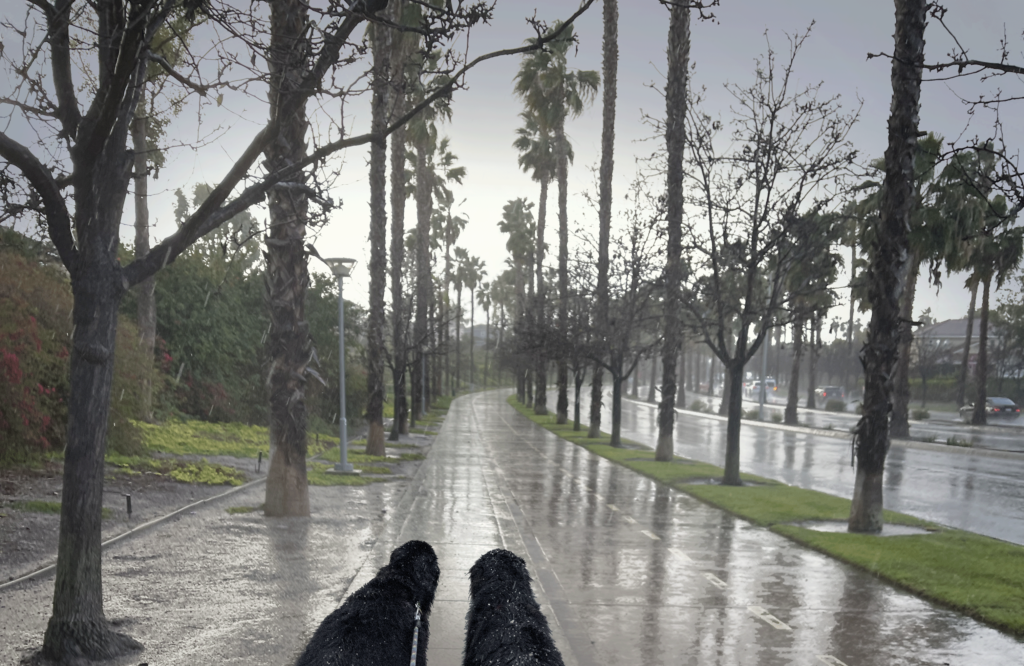
Southern California’s attitude to flooding is shifting from resistance to resilience.
Traditional Flood Control as a Form of Resistance
The Los Angeles River once flowed chaotically through a flood plain, before it was tamed into a concrete channel to spare the growing city from an ever-changing stream path, and potentially deadly floods. Our refusal to accept or comply with the natural flow of water fits the classic definition of resistance. While the channelization has been a success in terms of preventing catastrophic flooding, Kat Superfisky and Jessica Henson argue that it was at the cost of “ecosystem services (ES), habitat, and wildlife connectivity within the watershed, while creating social, cultural, and economic divides.”
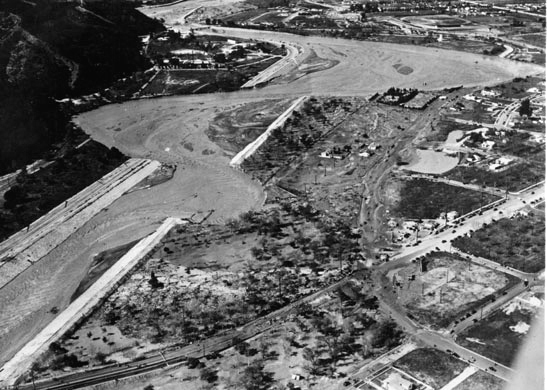
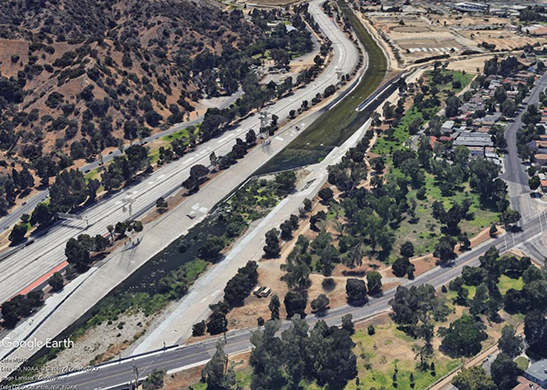
While resistance works to prevent flooding in a predictable single rain event, less predictability is on the horizon due to climate change. Recent research has raised questions about whether storm size will increase or decrease with warming, and changes are subject to regional variation. What if we could be resilient, embrace the capacity to recover quickly from disruptions, and accept the storms to come, in much the same way as our environment did prior to urbanization?
The Shift to Resilience
An argument for resilience was recently championed in an article in the journal Cities called “Rethinking urban storm water management through resilience“. This study makes a persuasive argument as to why we may be better off rolling with Mother Nature’s punches – as storm intensity and unpredictability exacerbated by impervious surfaces and high population density makes for a dangerous combination. In other words, if we hope to withstand more extreme weather patterns in the coming years, we need to design favoring resilience, understanding that some degree of failure in the system is inevitable. This means a paradigm shift in our efforts to resist the effects of a storm by quickly rushing floodwaters away through rigid channels, toward an approach that accommodates some localized storage of floodwaters in areas where damage is minimal, and where the effects of periodic flooding may be beneficial. Such a shift has been described by Jack Ahern as moving from fail-safe to safe-to-fail.
Some of this work is already being implemented. Planners, designers and land developers use various strategies to allow water to remain where it falls for longer, which go by many names: green infrastructure, water sensitive urban design, sponge cities, or low impact development (LID) being among the most common. Regardless of the name, the approach is similar: use nature-based solutions to instill resilience in the urban stormwater system.
This paradigm shift towards resilience means integrating storm water management practices into designs regardless of scale. Retention and detention basins reduce catastrophic failure further downstream by capturing the flow of stormwater and sediment. Potential for water inundation to slow, sink, and spread into the earth to replenishing local aquifers, many of which are being used to supplement municipal drinking water, is complicated by a myriad of factors including subsurface soil drainage capability and groundwater basin proximity. However, allowing water to seep into the soil, benefit from bioremediation, and passively provide water to nearby plants is beneficial instead of the customary polluted stormwater and sediment efflux to potentially sensitive ecotones.
At a regional scale, knowledgeable designers are working with nature, installing detention basins, rain gardens and vegetated bioswales. Instead of quickly channeling rainwater via curbs directly into piped infrastructure, the flow of rainwater is directed into the landscape, reducing rain inundated slick roads and lessening the potential for accidents. Cleverly designed inlets with trash receptacles capture any garbage flowing what would be toward the storm drain, reducing trash from entering streams, and making it easier to remove at the source.
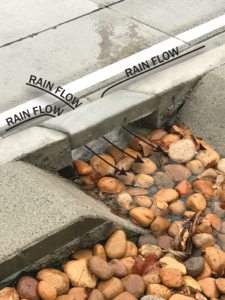
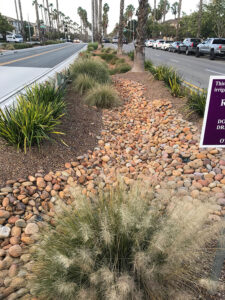
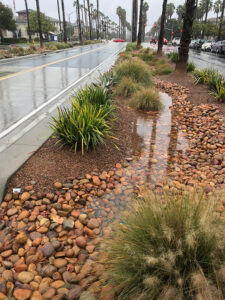
By looking at green space through the lens of holding the storm water on site for just a little while longer, we suddenly realize there is a lot of “non-functional turf” in our landscapes that could be better purposed with native plants, sequestering and cleaning water, and providing forage and habitat for insects and wildlife, instead of requiring additional irrigation to create an appearance of a landscape not suited to Southern California. With a “wider range of flooding” predicted due to climate change, these landscapes have the potential to add much needed flexibility to our cities flood response.
At the residential level we can mitigate storm water damage by installing gutters to direct the flow of water into rain barrels, cisterns, bioswales, and rain gardens (installed at least 10’ away from foundations), capturing “first flush” water runoff at a minimum. Concerns associated with rain barrels providing standing water potentially used as mosquito breeding grounds are minimized using rain barrels without concave surfaces and which have 1/16” mesh fitted at any opening. Vegetated bioswales, or rain gardens will typically drain in 24-48 hours once the storm is over, shorter than a mosquito larval and pupal stage.
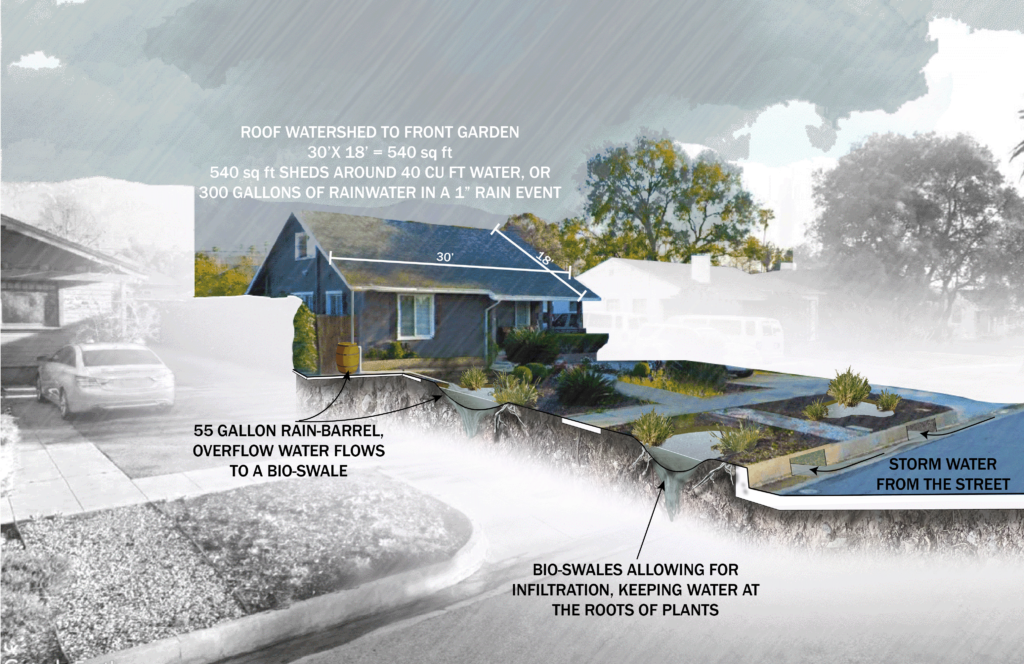
By replacing a parkway, non-functional turf, or a front garden, it could appear that non-native turf grasses are being targeted and sacrificed for the sake of a stormwater feature to use during a storm event – which feels like such a rare occurrence in Southern California. I’d argue that’s absolutely the ethically and ecologically right thing to do. Understanding that the typical cool season turf grasses require forty inches of water to grow, and our typical annual rainfall provides around fifteen inches, begs the validity of non-native turfgrass in times of water shortage. Additionally, lawns require repeated fertilizer supplements. Fewer lawns equal fewer fertilizing concoctions resulting in fewer fertilizers being washed into the storm drain, streams, rivers and ultimately our ocean.
By shifting strategies from “fail-safe” resistance to “safe-to-fail” resilience, cities can ameliorate some of what our changing environment promises is to come while simultaneously providing ecological benefits. As it’s estimated that 1/5 of Californians currently live in areas with a minimum of 1/500 chance of flooding in any year, we can be prepared for that eventuality by working with nature. In the face of increasingly dangerous weather patterns, thoughtful design can lead the way to respond to the storms to come.

Jeanine Sharkey is a 3rd year MLA candidate at California State Polytechnic University, Pomona. Her interests gravitate toward ecologically sensitive designs, native and Mediterranean plants, and making small incremental gains in the landscape that add up to substantial environmental benefits.